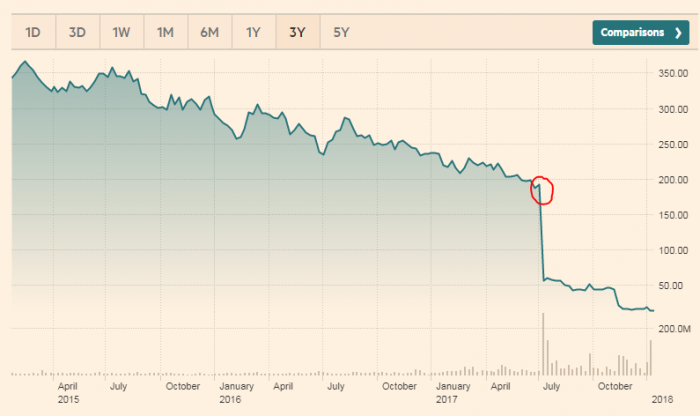Real World Read – Carillion Plc [Company in Difficulty]

The recent collapse of Carillion Plc in the UK provides a timely case study for CAP2 SFMA students on the topic of a company in difficulty. Carillion was the UK’s second largest construction contract with a host of public and private construction and facilities management contracts.
“How did you go bankrupt?” Bill asked.
“Two ways,” Mike said. “Gradually and then suddenly.”
The popular passage above from Ernest Hemmingway’s 1926 novel The Sun Also Rises most certainly applies to Carillion as although the liquidation came somewhat abruptly, the warning signs for Carillion from a number of angles appeared well before this.
Below shows the share price trend of Carillion Plc over the past three years.

Source: ft.com
Some key points to note about the company in recent times include;
- Hedge funds pocketed significant gains from Carillion’s collapse as they had shorted the shares as far back as 2014. At one point, over 25% of the shares in issues were shorted. See here for more on this. **
- As noted by many, there were some tell tale financial signs of problems in terms of mounting debt levels, poor trade payable management, and an increasing pension deficit – see here
- In mid July 2017 Carillion announced a suspension of its dividend for 2017, the departure of its CEO, and a profit warning. You can see the impact on the share price above with the red circle on the graph. – see here
** shorttracker.co.uk is a great site to see what short positions are held in UK firms – to my knowledge there is no such site for ISEQ lited companies. [To short a company means to borrow a share you do not own, sell it, and then hopefully buy it back when the price of the share falls – so you are betting on the share price falling as opposed to rising].
Some very good summary readings on the background to the decline and ultimate collapse of the firm include;
Another interesting insight is around all the stakeholders impacted by such a collapse (including Irish schools projects of which Carillion would have been a joint venture partner). Such stakeholders include public services (e.g. hospitals, schools, rail projects), 43,000+ workers, subcontractors, pensioners ( Carillion had a large pension deficit), banks (around £1.5bn in debt), investors (wiped out), UK government etc.
Any company going into liquidation has a lot more impact than just wiping out shareholders and this can be a key consideration when formulating any restructuring plan and we get back to the argument around the concept of some businesses being “too big to fail” – in this case the UK government did not think so (see here).

no comments